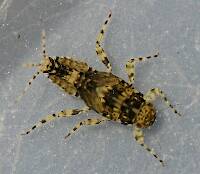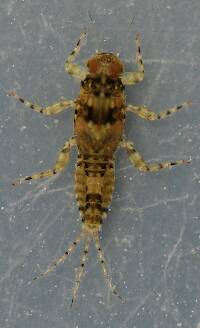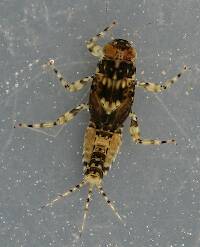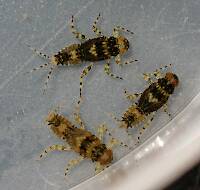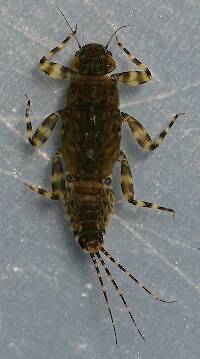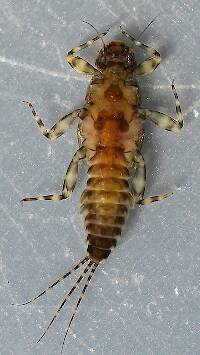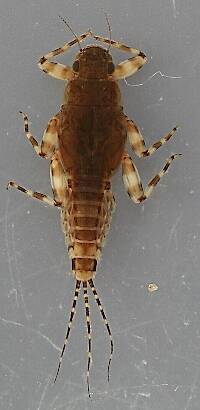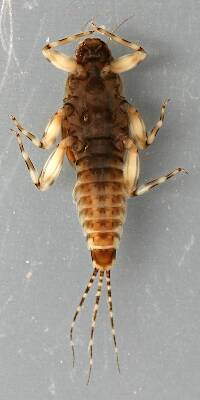
Blue-winged Olives
Baetis
Tiny Baetis mayflies are perhaps the most commonly encountered and imitated by anglers on all American trout streams due to their great abundance, widespread distribution, and trout-friendly emergence habits.
Featured on the forum

Some characteristics from the microscope images for the tentative species id: The postero-lateral projections are found only on segment 9, not segment 8. Based on the key in Jacobus et al. (2014), it appears to key to Neoleptophlebia adoptiva or Neoleptophlebia heteronea, same as this specimen with pretty different abdominal markings. However, distinguishing between those calls for comparing the lengths of the second and third segment of the labial palp, and this one (like the other one) only seems to have two segments. So I'm stuck on them both. It's likely that the fact that they're immature nymphs stymies identification in some important way.

Troutnut is a project started in 2003 by salmonid ecologist Jason "Troutnut" Neuswanger to help anglers and
fly tyers unabashedly embrace the entomological side of the sport. Learn more about Troutnut or
support the project for an enhanced experience here.
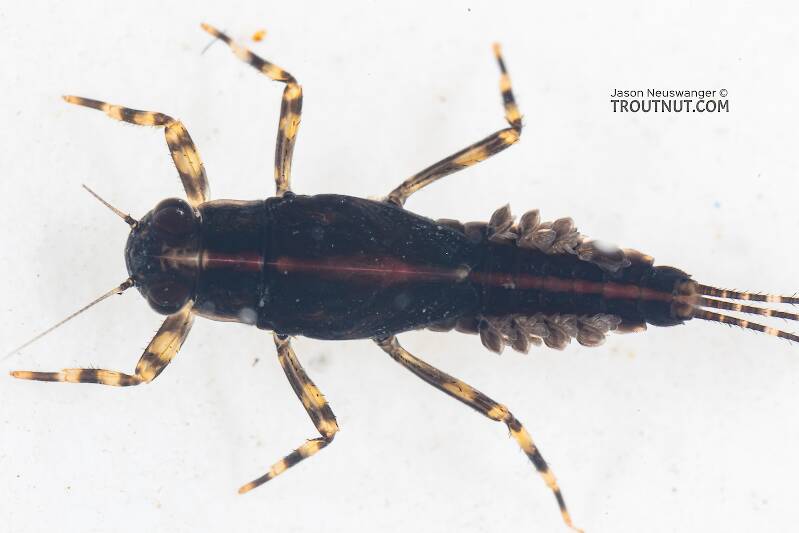
This specimen has tarsal claws with 7 denticles and tubercles on abdominal segments 4-7 only. It keys to Serratella micheneri, as do some other specimens from the same collection that lacked the dorsal stripe.
Millcreek on Dec 24, 2019December 24th, 2019, 2:31 pm EST
This nymph appears to be Ephemerella tibialis formerly known as Serratella tibialis. Check out Allen and Edmunds; http://www.ephemeroptera-galactica.com/pubs/pub_a/puballenr1963p583.pdf
Also check https://bugguide.net/node/view/696565/bgpage and https://bugguide.net/node/view/876178
Edit: Just noticed the other two Serratella micheneri sets of photos. These also appear to be Ephemerella tibialis.
Also spotted these two sets of photos where you identified the same or a similar nymph as Ephemerella tibialis.
http://www.troutnut.com/specimen/1176
http://www.troutnut.com/specimen/1178
Also check https://bugguide.net/node/view/696565/bgpage and https://bugguide.net/node/view/876178
Edit: Just noticed the other two Serratella micheneri sets of photos. These also appear to be Ephemerella tibialis.
Also spotted these two sets of photos where you identified the same or a similar nymph as Ephemerella tibialis.
http://www.troutnut.com/specimen/1176
http://www.troutnut.com/specimen/1178
"If we knew what it was we were doing, it would not be called research, would it?"
-Albert Einstein
-Albert Einstein
Troutnut on Dec 25, 2019December 25th, 2019, 3:19 pm EST
I keyed this one under the microscope using a more recent key than Allen and Edmunds:
Jacobus, L. M., N. A. Wiersema and J. M. Webb. 2014. Identification of Far Northern and Western North American mayfly larvae (Insecta: Ephemeroptera), north of Mexico. Joint Aquatic Science meeting, Portland, OR. 176 pp. + suppl. Unpublished workshop manual.
The couplet on page 64 distinguishes E. tibialis from the other species:
If I'm remembering correctly (and I might not be), I looked pretty hard at the maxillary canines and the thoracic nota under the microscope and couldn't find the characteristics pointing to tibialis. It is a bit odd that I didn't mention that in the captions, though, so perhaps I'm misremembering or I just failed to interpret the characteristics correctly.
The key does describe Serratella as having "Abdominal terga either without tubercles or with relatively large, blunt and somewhat sinuate tubercles", and one of the other specimens I labeled as micheneri seems to have sharper tubercles than those shown in the corresponding illustration in the key.
Perhaps Luke can weigh in?
Jacobus, L. M., N. A. Wiersema and J. M. Webb. 2014. Identification of Far Northern and Western North American mayfly larvae (Insecta: Ephemeroptera), north of Mexico. Joint Aquatic Science meeting, Portland, OR. 176 pp. + suppl. Unpublished workshop manual.
The couplet on page 64 distinguishes E. tibialis from the other species:
81e) Maxillary canines strongly serrate laterally; thoracic nota with small, brown excrescences (sometimes difficult to detect), especially between forewingpads = Ephemerella (Vittapallia) tibialis (very similar to E. nuda)
81e’)
Maxillary canines not obviously serrate laterally; thoracic nota without small, brown excrescences = 81f
If I'm remembering correctly (and I might not be), I looked pretty hard at the maxillary canines and the thoracic nota under the microscope and couldn't find the characteristics pointing to tibialis. It is a bit odd that I didn't mention that in the captions, though, so perhaps I'm misremembering or I just failed to interpret the characteristics correctly.
The key does describe Serratella as having "Abdominal terga either without tubercles or with relatively large, blunt and somewhat sinuate tubercles", and one of the other specimens I labeled as micheneri seems to have sharper tubercles than those shown in the corresponding illustration in the key.
Perhaps Luke can weigh in?
Jason Neuswanger, Ph.D.
Troutnut and salmonid ecologist
Troutnut and salmonid ecologist
Millcreek on Dec 26, 2019December 26th, 2019, 3:01 am EST
Found these pictures at Bold. They're not very good quality but may give enough to identify the critters.
http://v3.boldsystems.org/index.php/Public_SearchTerms?query=%22Serratella%20micheneri%22[tax]
http://v3.boldsystems.org/index.php/Public_SearchTerms?query=%22Ephemerella%20tibialis%22[tax]
It would be nice to hear from Luke.
http://v3.boldsystems.org/index.php/Public_SearchTerms?query=%22Serratella%20micheneri%22[tax]
http://v3.boldsystems.org/index.php/Public_SearchTerms?query=%22Ephemerella%20tibialis%22[tax]
It would be nice to hear from Luke.
"If we knew what it was we were doing, it would not be called research, would it?"
-Albert Einstein
-Albert Einstein
Quick Reply
Related Discussions
Topic
Replies
Last Reply
0
Sep 26, 2020
by Millcreek
by Millcreek
Re: Here's two I could use some help with from East Tennessee! 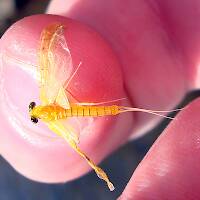
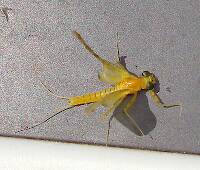
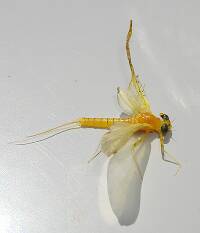
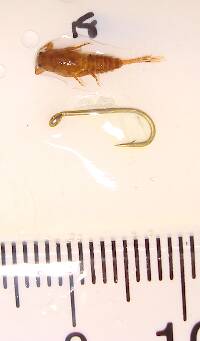
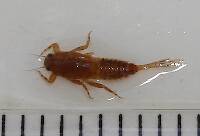
In the Identify This! Board by BrettHRomer
+ 1





In the Identify This! Board by BrettHRomer
6
May 8, 2008
by JOHNW
by JOHNW
10
Apr 29, 2009
by Troutnut
by Troutnut



